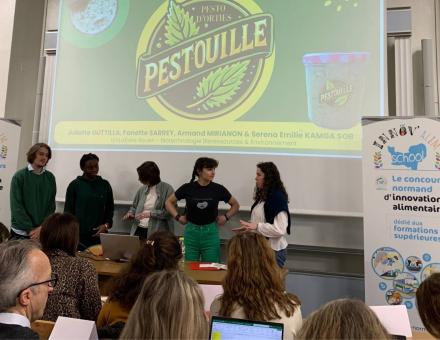Read the new article of the AGHYLE unit of UniLaSalle published in the media The Conversation.
Michel-Pierre Faucon, UniLaSalle; David Houben, UniLaSalle; Isabelle Trinsoutrot Gattin, UniLaSalle and Nicolas Honvault, UniLaSalle
Like all living organisms, plants cannot do without phosphorus, which is a major element for their nutrition and the productivity of agroecosystems. However, due to the nature of its chemical forms, phosphorus is not readily available to plants in the soil. The fertilization of crops with phosphorus was thus an essential element in the development of agriculture; today, this fertilization is still required to maintain food production.
However, phosphate fertilization is a source of contamination - in toxic metals, notably cadmium and uranium - of cultivated soils; this is mainly due to the impurities present in certain phosphate rocks used to manufacture these fertilizers. In France, about 410,000 tons are consumed each year (and 2.6 million tons for the European Union).
Too much #cadmium, a metal dangerous to health, in French agricultural fertilizers? Soil specialist Thibault Sterckeman answers on @FR_Conversation @Inra_France @Univ_Lorraine https://t.co/EGhv4ERbrz #agriculture #health pic.twitter.com/s7fII4M8Mc- Jennifer Gallé (@galle_jennifer) July 3, 2018
Yet cadmium accumulates in the food chain. And it is known that cadmium exposure in humans (non-smokers) comes mainly from soil contamination by phosphate fertilizers.
Classified as a human carcinogen by the World Health Organization, several European Union countries have adopted regulations setting a lower or equal limit ranging from 60 to 20 mg of cadmium per kg of phosphate fertilizer.
Recycling phosphorus accumulated in the soil
Phosphate rock mining resources with low cadmium content are finite and exhausted in Europe; they have also become scarce worldwide (a deposit is present in Russia). Faced with this scarcity, new circular economy systems and new practices need to be put in place to secure agricultural production.
One of the current challenges concerns the recycling of phosphorus within our territories, in particular by recovering animal and human excrement, but also by increasing the availability of phosphorus accumulated in cultivated soils following a long history of fertilization. The aim is to reduce mineral phosphorus inputs of fossil origin and losses through runoff.
The first and most sustainable objective - before making new inputs of renewable phosphorus involving transport and greenhouse gas emissions - is therefore to recycle the phosphorus accumulated in soils by improving its availability, i.e. in a chemical form that can be assimilated by the plant.
There are various ways to achieve this, notably through certain agroecological practices.
Valuing the genius of plants and soil microorganisms
Practices based on the principles of agroecology (which proposes to examine the functioning of agrosystems and to integrate ecological processes) can offer an opportunity to limit phosphorus losses and improve its availability in cultivated soils to make its use more efficient.
Before mobilizing this unavailable phosphorus in soils, one of the priorities is to limit losses through runoff in order to both save money and reduce surface water pollution (the so-called eutrophication phenomenon).
During rainy seasons, plants, and more generally crops that cover the soil completely, limit the energy of water drops and the formation of intense runoff. Those with a high density of fine roots per volume of soil promote water permeability and infiltration, thus reducing runoff and phosphorus transfer to surface waters.
Plants with vertical stem and leaf density also provide a vegetative barrier to reduce runoff and associated phosphorus losses. Crops with all these characteristics are therefore recommended to reduce runoff losses.
Several species and varieties, adapted to low phosphorus availability or moderately demanding (such as white lupin), increase their root length, density of absorbing hairs and associate with symbiotic fungi (mycorrhizae) to respond to the spatial heterogeneity of phosphorus in the soil, improving its exploration and absorption.
Focus on complementarity
Soil microorganisms, and more specifically soil microorganisms adhering to the roots, are capable of improving phosphorus availability.
There are bacteria that mineralize organic phosphorus (not very available) thanks to the activity of their enzymes (called phosphatases or phytases) or that solubilize unavailable forms.
Fungi can participate in this mobilization by exuding small organic molecules that take the place of phosphorus fixed (blocked) on soil constituents. These microbiological phenomena should therefore be exploited to recycle the phosphorus stored in the soil. When the soil does not have these microbiological functions, these microorganisms can be applied to the sown seeds in order to improve phosphorus availability.
Some cultivated species and varieties - such as faba beans, hairy vetch, lentils - have particular characteristics in their roots to increase phosphorus availability and uptake. These characteristics have been highlighted over the last decade and now constitute a knowledge base for composing crops that favor this availability and thus its recycling within the agroecosystem.
However, there is no such thing as a "super plant" that would mobilize phosphorus in the soil: plants cannot mobilize all the morphological, symbiotic and chemical characteristics necessary for this purpose. It is, for example, plants with thicker roots (such as faba beans and lentils or grasses) and shorter root lengths that associate with mycorrhizal fungi engaged in soil exploration. Plants with long and thin roots (such as phacelia, Alexandria clover, rough oats) will be less associated with these fungi and will therefore release less exudates that favor phosphorus availability.
Complementarity at the scale of a cultivated plant community therefore seems to be essential.
Combining crops
Several studies have highlighted the role of multi-species or multi-variety crops in rapidly improving phosphorus availability in agroecosystems; variety diversity, combining two harvested crops, relay crops and companion crops (planted to provide certain services).
The integration of intermediate crops, planted between two crops to cover the soil and avoid nitrogen losses and water pollution, composed of species that are efficient at acquiring phosphorus, is one practice that can increase phosphorus availability. These crops absorb a quantity of phosphorus that is then released during the mineralization of their residues, benefiting the following crop and allowing the reduction of phosphate fertilizer input.
From now on, it will be a matter of combining the use of renewable phosphorus resources present on a territorial scale with the development of crops and varieties that meet the requirements of agricultural sectors and improve the availability of phosphorus in soils.The Conversation
Michel-Pierre Faucon, Teacher-researcher in plant ecology and agroecology - UniLaSalle Beauvais Research Director, UniLaSalle; David Houben, Teacher-researcher, soil science, UniLaSalle; Isabelle Trinsoutrot Gattin, Director of the Agroecology Research Unit, UniLaSalle and Nicolas Honvault, Post-doctoral student, agroecology, UniLaSalle
This article is republished from The Conversation under a Creative Commons license. Read the original article.






